The Intel Haswell Refresh Review: Core i7-4790, i5-4690 and i3-4360 Tested
by Ian Cutress on May 11, 2014 3:01 AM ESTReal World Benchmarks
2D to 3D Rendering –Agisoft PhotoScan v1.0: link
Agisoft Photoscan creates 3D models from 2D images, a process which is very computationally expensive. The algorithm is split into four distinct phases, and different phases of the model reconstruction require either fast memory, fast IPC, more cores, or even OpenCL compute devices to hand. Agisoft supplied us with a special version of the software to script the process, where we take 50 images of a stately home and convert it into a medium quality model. This benchmark typically takes around 15-20 minutes on a high end PC on the CPU alone, with GPUs reducing the time.
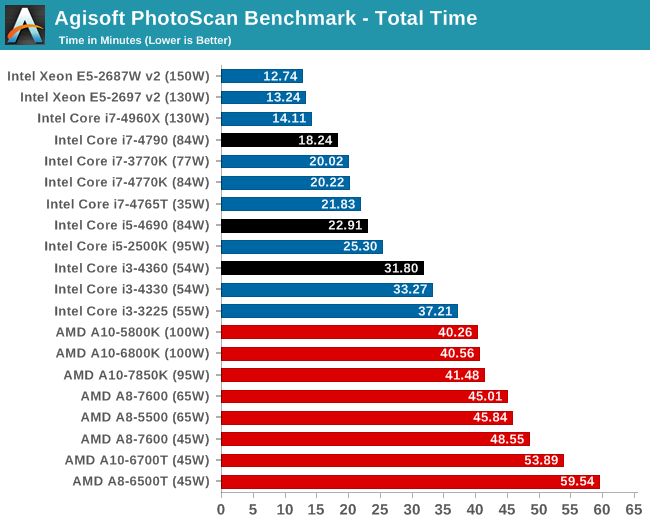
For Photoscan we see the incremental speedup with the i3 models, but the increased single thread speed of the i7 makes more of a difference.
Compression – WinRAR 5.0.1: link
Our WinRAR test from 2013 is updated to the latest version of WinRAR at the start of 2014. We compress a set of 2867 files across 320 folders totaling 1.52 GB in size – 95% of these files are small typical website files, and the rest (90% of the size) are small 30 second 720p videos.
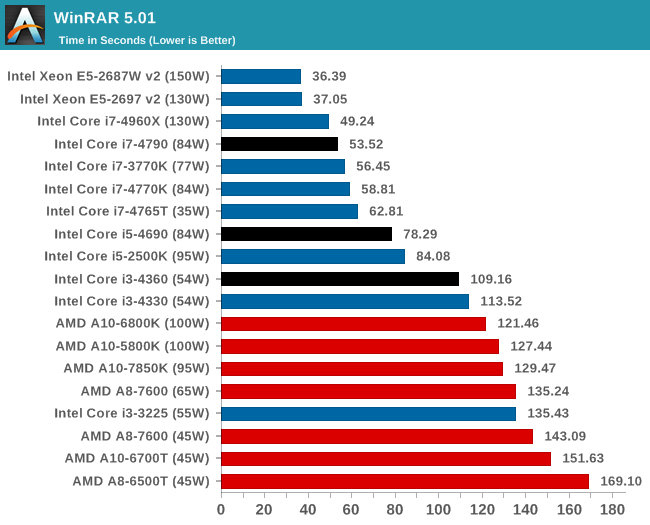
For WinRAR, the increase in the threads makes the most difference here, moving from i5-4690 to i7-4675T.
Image Manipulation – FastStone Image Viewer 4.9: link
Similarly to WinRAR, the FastStone test us updated for 2014 to the latest version. FastStone is the program I use to perform quick or bulk actions on images, such as resizing, adjusting for color and cropping. In our test we take a series of 170 images in various sizes and formats and convert them all into 640x480 .gif files, maintaining the aspect ratio. FastStone does not use multithreading for this test, and thus single threaded performance is often the winner.
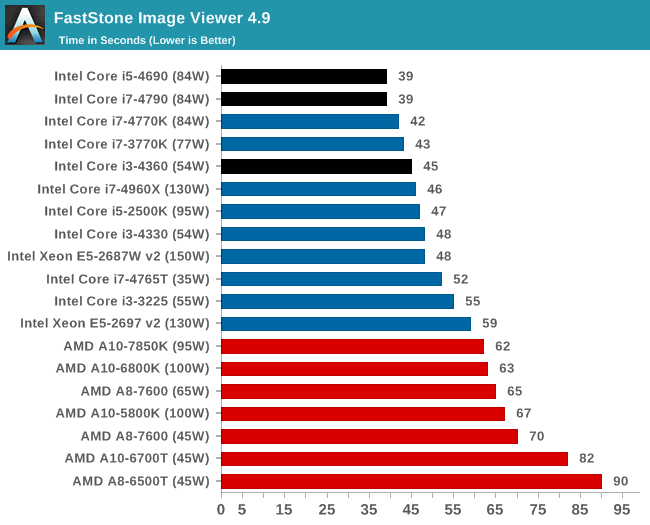
FastStone is all about the single thread speed.
Video Conversion – Xilisoft Video Converter 7: link
The XVC test I normally do is updated to the full version of the software, and this time a different test as well. Here we take two different videos: a double UHD (3840x4320) clip of 10 minutes and a 640x266 DVD rip of a 2h20 film and convert both to iPod suitable formats. The reasoning here is simple – when frames are small enough to fit into memory, the algorithm has more chance to apply work between threads and process the video quicker. Results shown are in seconds and time taken to encode.
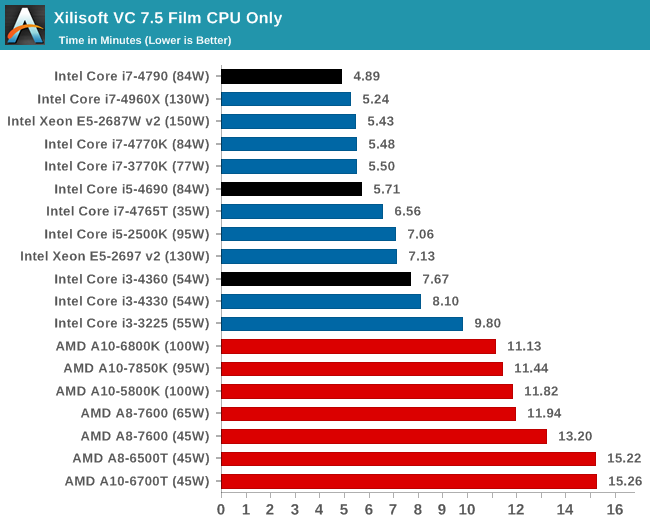
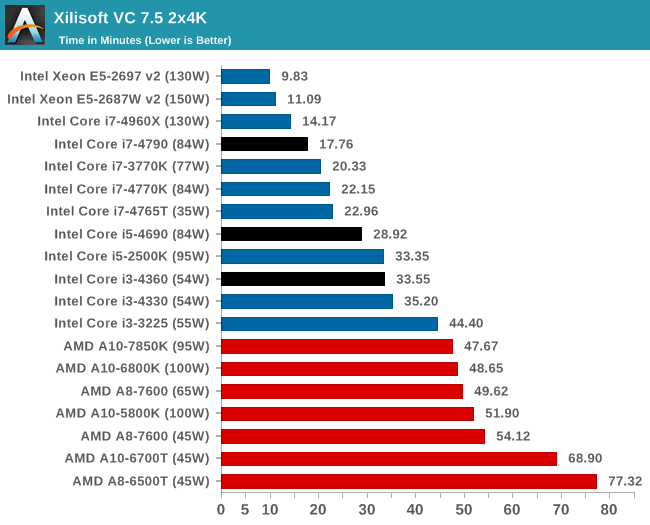
Small frames prefer more single thread MHz, whereas the dual 4K frame conversion prefers threads.
Video Conversion – Handbrake v0.9.9: link
Handbrake is a media conversion tool that was initially designed to help DVD ISOs and Video CDs into more common video formats. The principle today is still the same, primarily as an output for H.264 + AAC/MP3 audio within an MKV container. In our test we use the same videos as in the Xilisoft test, and results are given in frames per second.
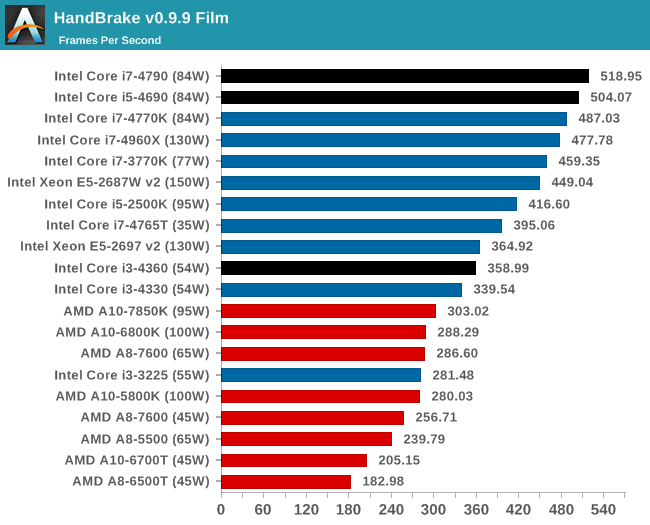
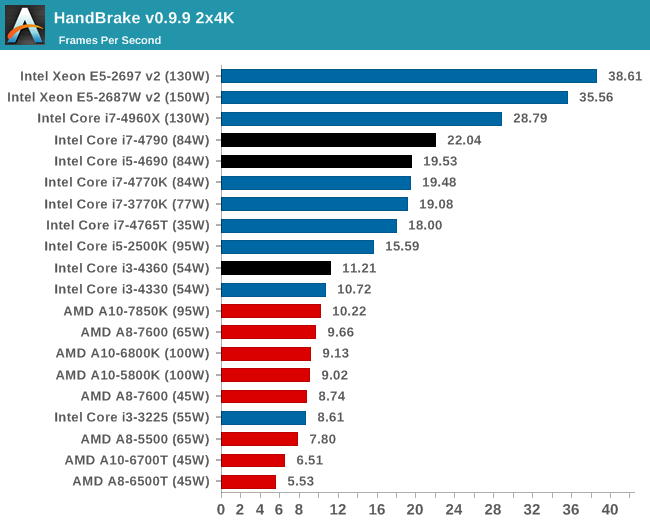
With Handbrake it would seem that it prefers actual cores rather than hyperthreading, given by the i5 and i7 being relatively close and 2x the i3.










130 Comments
View All Comments
etamin - Sunday, May 11, 2014 - link
I feel that a whole lot of unnecessary effort was put into the benchmarks. But we appreciate the effort of course.I'm looking forward to SATA Express. Are there any compatible consumer level M.2 SSDs currently available?
weilin - Monday, May 12, 2014 - link
Yup, look for the models below in M.2 interfaceIntel: 530
Crucial: M500, M550
Misc: MyDigitalSSD, Samsung (only second hand/OEM stuff, no retail presence)
jjj - Sunday, May 11, 2014 - link
But there is competition, more than they ever had. You got tablets and phones killing PC sales and Intel is just sabotaging the only PC segment able to create any hype around PC. There is nobody else that really gives a damn about their products but hey they would rather have 60% margins instead of 58% even if they lose us too.Instead of giving us a 300$ 8 cores chip with no GPU, they are giving away free tablet Atom because that will help.....
juhatus - Sunday, May 11, 2014 - link
I totally agree, Intel should really push PC again, not replace schim's with better ones.bji - Sunday, May 11, 2014 - link
Intel cannot generate sufficient returns on its R & D dollars anymore. Nobody in the consumer market cares that much about faster Intel chips except CPU enthusiasts, and it's not a market that can even come close to supplying enough money to fund the R & D necessary to significantly advance x86 performance.You can blame AMD for not supplying enough competition, but a bigger part of the equation is that faster Intel chips don't sell "enough more" than current generation ones to justify spending huge amounts of R & D money on them.
You can look at this as a sad fact, but I actually like it. I can by a laptop now for cheap that is so overly spec'd for my needs that I essentially never need to upgrade, saving me money. Software companies cannot depend upon ever increasing chip speeds, they have to become better at producing efficient software in order to have the headroom for new features that used to be provided by ever increasing chip speed.
Advances in mobile computing are where it's at, and everyone knows that already ...
Antronman - Monday, May 12, 2014 - link
Buddy, you've never built a PC, and I'm assuming that you don't have a hardware-heavy job.bji - Monday, May 12, 2014 - link
Wrong on both counts.Shadowself - Monday, May 12, 2014 - link
To some extent you're correct, but the reality is that the reasons are interdependent.Current performance increases from one generation to the next (Sandy Bridge to Ivy Bridge to Haswell and anticipated into Broadwell) are only 10% - 20% per generation. I, and many like me, buy at the top of the performance range and now use that machine for a few years so that we get a significant performance jump with each new machine purchased. Back 20+ years ago when each generation was 50% to 100% faster I upgraded each generation. It's just not worth it to do so anymore for just a 10% - 20% increase. The aggregate cost of purchasing machines every generation over a few years for such moderate increases in performance is too high.
Likely Intel (and AMD) are into the range of diminishing returns on performance increases. Unless there are huge architecture changes in the upcoming Skylake series I expect the 10% - 20% increase per generation to continue for at least three more generations -- Haswell to Broadwell, Broadwell to Skylake, and Skylake to Cannonlake -- (and maybe go to 5% -10% performance increase in the Skylake to Cannonlake transition).
Small increases in performance keep people from buying every generation. People not buying every generation limits profits and what can be put into IR&D. Limited IR&D produces small increases in performance. And the cycle repeats.
alacard - Monday, May 12, 2014 - link
The increases over the past few generations have been no where near 10-20 percent.Sandy to Ivy was ~5 with that increase coming solely from power management/boost tweak. Clock for clock the cores perform identical (to get this metric you simply disable all the power management/boost functions in the bios and benchmark from there) with Ivy offering a slight decrease in consumed wattage.
The Ive to Haswell performance increase - with a few exceptions - is < 10% in almost all tests, with consumed wattage actually increasing from ivy.
Unfortunately, the Intel performance curve over the past 4 years is actually far more compressed than you paint in your post. With the exception of a couple of new task specific instructions we've had essentially less than 10% performance gains during that time
BadThad - Monday, May 12, 2014 - link
I agree Shadowself! I'm actually still mainly on a Q6600 system as it meets all of my needs. At last I'm at the point where I'm going to Z97 as the performance benefits and feature sets are finally worth it for my needs.